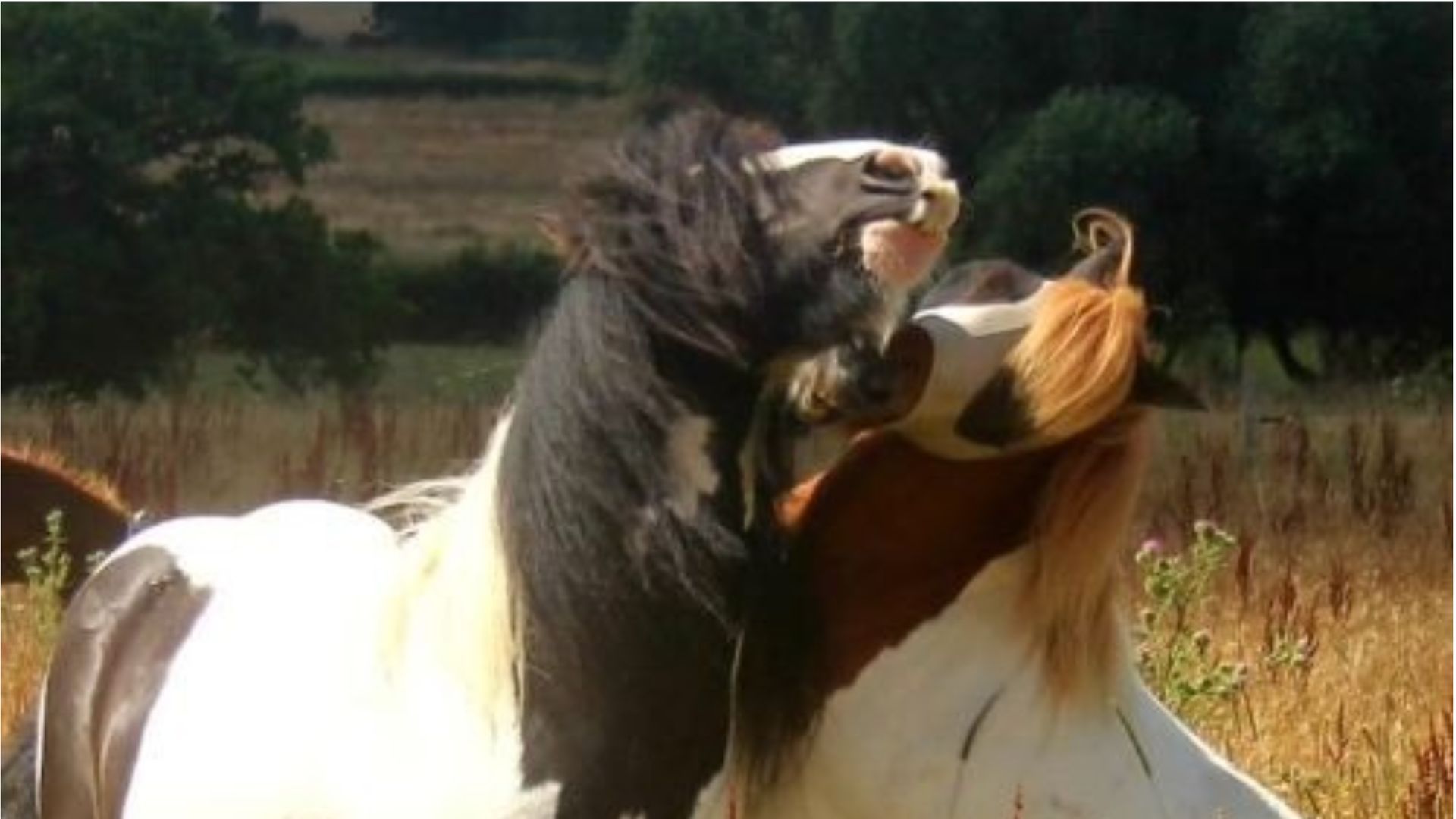Why does my horse react to the spring pollens?
The latest on Histamine Intolerance, aka MCAS - Mast Cell Activation Syndrome
Back in 2006, a rather fetching former show-cob named Kelso joined our family. We knew him already as our trainer’s riding horse, but then she got sick so needed to rehome him. We leapt at the chance as he was the nicest big chap you could ever meet, a soppy dollop of a gentleman and seriously handsome to boot.
We knew about his chronic sweet itch, and that he was also a chronic springtime headshaker, yet when he came to live with us in the August, he also had a severe hacking cough. Within a week Kelso had confined himself to barracks because he literally couldn’t get enough breath to step out of his stable.
Of course I called the vet, who diagnosed ‘chest infection’ and wrote him the usual script of ventipulmin, antibiotics and bute (what we now know as the very cocktail of pharma meds that destroy immune cells when Kelso needed his immunity at its strongest, never mind annihilating his gut microbiome, but in fairness, back then no-one knew about the microbiome).
No surprise, Kelso got sicker, so 2-weeks later he got another round of the same drugs, and another 2-weeks after that, when Kelso could barely breathe anymore and was on a slippery downward spiral, the vet told me to have him PTS. His reason? Wait for it – because “He’s old,” and therefore "wasn’t going to get better." Er ... Kelso was only 17, so not exactly ancient. Far from it. Never mind that he’d only been with us for a month, and seriously unwell for the entirety …
That’s when I turned into fire-breathing dragon-lady and did what any reasonably intelligent woman would do – I hit the world-wide-web, googling anything, anything, that could help our big man. I finally landed on those whacky things called ‘herbs’, and the rest is EquiNatural history. Kelso was better in 3-days.
Definitely one of life's hindsight moments - "If only I knew then what I know now." 😉 As we now know, what Kelso had was a chronic pollen allergy, with his respiratory responses moving seamlessly from the spring pollen classic symptoms - extreme nose-rubbing, head-burying and violent headshaking - to the summer grass pollen symptoms, where the hotter summer’s humidity holds the pollens in the air and creates a catastrophic chest congestion. Kelso's airway inflamed and narrowed, and his lungs became so congested that his nostrils desperately flared as he tried to breathe, and with each agonising wheezing breath he developed deep heave lines along his sides.
It wasn’t a chest ‘infection’ as the vet (expensively) diagnosed, and yes, those prescribed drugs nearly killed him. Yet those herbs I found opened up his upper respiratory tract, soothed the irritation, calmed the asthmatic symptoms, and overall alleviated his torture. With a few tweaks later, that herb mix eventually became our BreathePlus, and gave Kelso a further six comfortable summers, with (what also became) our PollenTonic from March-ish till the weather got hot and we then switched him over to the BreathePlus. Oh, and not forgetting what also became our SwItchTonic for his sweet-itch. No doubt about it – ‘Allergy’ was Kelso’s middle name, but back then we simply accepted that this was Kelso’s lot, and so long as we could alleviate his symptoms we could keep him comfortable.
Fifteen years later ...
Cut to spring 2021, and with my EquiNatural hat on, for the last 15-years I’ve been deeply entrenched in all things Functional Medicine, where new research on 'Histamine Intolerance' crossed my path, and because it was very much connected to pollen allergies I wrote a blog on it - Histamine Intolerance - The new kid on the block.
Of course it was all based on human research as very little money is spent on equine research, but as with many human health issues we can translate the knowledge to our horses. And this was no exception - recent human research was now showing that all-things-allergy were connected to the body producing too high levels of histamine, with the triggers being our old friends - bad diet/lifestyle stressors/unhealthy environment, so the immune cells were going into overdrive, producing too much histamine which – and here’s the quirk of it all – caused its own allergic response! And amongst other issues, this worsened already established respiratory allergies, with humans - and our horses - suffering all the more.
The research noted that this syndrome of excess histamine production had become so prevalent that a new label was created - 'Histamine Intolerance', with its own allergic response making the body feel seriously crap, so much so that it became recognised as a 'spectrum' illness, with mild, moderate and severe levels to it. And by digging deep into the syndrome, it was established that :
- histamine was being overproduced, which created it's own added allergic response into the mix,
- the body reacted and developed a ‘resistance’ to it,
- it was triggered by mast cells, one of the white blood-cell team of immunity-protector cells.
The only remaining question was Why?
Mast cells
Now, mast cells are actually one of the body’s best friends, having a key role in the initiation of adaptive immune responses, literally the body's defense system killer army, and specifically relating to their role against allergies.
* A quick digress on the immune system, because the body has two versions of immunity:
- The Innate, or nonspecific, immune system, is the first-line defense system that we're all born with. It protects us against all antigens/toxins/pathogens, putting up barriers that keep harmful materials from entering the body. The 'non-specific' label means it doesn't differentiate between different types of pathogens.
- Then there's the Adaptive immunity, which is built up as we're exposed to diseases or get vaccinated. It involves specialised immune cells (lymphocytes) and antibodies that attack and destroy foreign invaders, and what's funky about it is that it remembers those invaders for any future attacks. Mast cells are part of the Adaptive immunity.
Back to mast cells, and as at 2021 it was now recognised that they can over-react, meaning that everything basically goes horribly wrong, triggering an intolerance to the very chemical compounds the body was releasing to fight the allergy.
As this syndrome was now all too prevalent, it was given a new medical diagnosis – MCAS - Mast Cell Activation Syndrome, which is not just on the rise, it was significantly on the rise, as shown by the huge increase in humans experiencing more severe hay-fever symptoms in spring, and chest congestion in summer. Just as we've been seeing in our horses, with this same intolerable allergic response also very much on the rise over the last few years.
So that was 2021, and two years on, 2023, there’s more development. Meet one of the pioneers of mast cell disease research, Dr Lawrence Afrin. Dr Afrin has many publications to his credit on mast cell disease outside the medical literature, which has given new hope to (human) patients struggling with it long-term. He’s contributed to numerous peer-reviewed research studies on the subject and has served on several medical advisory boards, as well as also establishing a centre for advancing research, education, and patient care for mast cell activation syndromes.
So all in all, Dr Afrin’s the goto for the latest on this relatively new medical disease, and ... I've recently listened to an awesome podcast on this very subject featuring him. Of course this is my manna from heaven and what floats my boat, so I took copious notes and transcribed the salient points here in this blog. So, if you or your horse suffers from spring through summer pollen-related allergies, or any allergy for that matter, here's where the latest research sits which may resonate with you, because this is where it's all at. So here we go ...
MCAS - Mast Cell Activation Syndrome
To kick off the podcast conversation, Dr Afrin was asked to introduce the biological purpose of mast cells in the body and give us an example of healthy mast cell function versus unregulated, hyperactive function. As he put it, we only get to hear about mast cells when they’re the villains, but they’re there for a reason, and when they function normally they’re a critical part of the adaptive immune system, helping the body to resist and recover from assaults, traumas, infections, and so on.
What’s now clear is that hypersensitive mast cell activation is an underlying cause of illness with many diagnoses, presenting as episodic inflammatory symptoms that come and go over time, which historically (no surprise) has made them difficult to diagnose. These fluctuating symptom patterns include allergic-type responses and non-specific symptoms ranging across the cardiovascular, endocrine, gastrointestinal, and - as we know only too well as we head into spring - the respiratory system. And it’ll probably come as no surprise to you that it affects the overall immune system as a whole.
Mast cells usually sit in all the different tissues in the body fairly quietly, keeping sensory tabs on the environment around them, largely doing nothing as long as we’re healthy. However, the moment they sense an assault they swing into action, producing and releasing various of their many, many, different mediators, namely various signalling chemicals that float out into the surrounding tissues. And when these mediators bind with other cells in the vicinity, this then influences those cells to adjust their own function to help the body best resist, and recover from, the specific insult that just hit. In other words, this is as it should happen normally.
Usually this system works very well; mast cells really are the frontline sentinels of assaults on the body, swinging into action faster than any other type of immune cell. And as long as they’re putting out the right mediators in the right amounts, at the right times for the right durations, and in the right places in the body, all is well, giving the body an amazing capacity to resist and recover from assaults. However, if some of these mast cells start misbehaving, and they start putting out the wrong mediators in the wrong amounts, at the wrong times for the wrong durations, and in the wrong places, the other cells and tissues on the receiving ends of those mediators don’t realise they’re getting the wrong signals, because they’re biologically programmed to react when these mediators come at them, irrespective of whether the mediators are right or wrong.
So, what you get with a mast cell activation disorder, aka MCAS, is that you have all these different tissues and organs and systems in the body that are reacting differently to how they should, so a positive recovery doesn’t happen, with the reaction entirely dependent on which mediators are coming out of these dysfunctional mast cells in which amounts, times, durations, locations, so … Phew. It’s an extraordinarily complex situation.
So why don’t our GPs (and vets) know about this? Simple. Because this is really new research, and has never been recognised until recently. Medical practitioners get about one-minute in their decades of training on mast cell biology and disease, and this is because the science didn’t start to understand that mast cell activation syndrome even existed up until about 15-years ago. Hence why all we've ever been able to do is block the symptoms over the decades because the science hasn't caught up with it. Until now 😉.
What basically gets covered in that minimal training is the general understanding that mast cells produce just a couple of mediators, our old friend histamine and tryptase. We've always had a fairly good idea of what histamine does in the body, i.e. in the right quantity it mediates/normalises the allergic reaction, but when there’s excess histamine production, the allergic reaction becomes significantly amplified. As for tryptase though, and despite it being studied for more than half a century, the science still doesn’t fully understand what the principal role of tryptase is in human biology, so the whole subject is challenging for sure.
The only other known mast cell disease over the last century or so is an extremely rare disease, a cancer of the mast cell called mastocytosis, that most doctors will never see a case of in their lifetime. And this is kind of why, if it’s unlikely that a doctor isn’t going to see, or at least recognise, any kind of mast cell disease, why spend time learning about it? However – cut to today and the research is breaking through, starting to understand that firstly, the root of allergies lies with mast cells, and that they can go wonky and disrupt other cells’ function, aka an 'activation syndrome'. And it's now recognised as incredibly prevalent, presenting a need for doctors to learn and understand a whole lot more about the biology of it all.
As it happens, the biologists have long known that mast cells produce not just these two mediators but actually more than a thousand, each of which has a huge range of very potent effects on different systems and tissues in the body. And this is the fundamental reason why this one disease, so to speak, with a myriad of different variants, is actually capable of presenting in so many different fashions at a superficial clinical level. Hence why the research is starting to understand why this area of medicine is so complex, and why basically, to date, there’s not been an effective cure.
So, two major pointers here:
- First up, it’s relatively new knowledge on the frontline that mast cells release more than a thousand different mediators.
- Second, mast cells have a instant, nano-second response to an assault, which is fairly profound.
So what triggers a mast cell response, and what might be the underlying causes of an inappropriate mast cell release?
Sorry - a bit of a 🤓Science Alert!🤓 coming up ...
Bear in mind that the research to date is based on around 15-years’ worth since the first case reports were published (which is not a long time for scientific research), not that it’s a new disease but more a newly recognised disease. But what seems to be emerging from the preliminary research fairly consistently is that in almost every MCAS patient, what’s seen is a bevy of different mutations in various genes inside the dysfunctional mast cells, the very genes that are important in regulating the behaviours of the mast cells.
The research also makes clear that pretty much every different MCAS patient has a different set of these mutations. There might be some overlap from one patient to the next, but by and large, each patient seems to have a unique set of mutations. And it’s the totality, the net result of the particular set of mutations, that are present in any given patient, that drives a certain baseline level of misbehaviour of those dysfunctional mast cells. The science is not saying that all the mast cells are mutated; what’s being seen is that it’s actually only a minority of them that are mutated.
Dr Afrin says they also know that these mutations, by and large, are not inherited. Yep, you’ve guessed it – it’s the old lifestyle thing again. They’re largely acquired at various stages in a patient’s life, although the research is still looking at how and why they get acquired. However, what’s absolutely known is that these mutations create a certain baseline level of misbehaviour of the mast cells. And then when you add into the mix the exposures that different people have to different elements of diet, lifestyle and the environment that these dysfunctional mast cells will excessively react to, you multiply all these variables together and you get an almost infinite number of permutations of different ways this disease can behave in different people. And our horses.
So, if these appear to be acquired mutations, here’s the question … if we tweak the lifestyle factors, could the responses perhaps be modified?
Our old friend Inflammation
Thing is, like every fingerprint is unique, the disease behaves differently in every patient. However, there appear to be some general themes to it. There are actually patterns, and they tend to follow along the lines of the general effects of the majority of the mediators that are produced by the mast cells. And given that a recurring effect is multisystem inflammation, inflammation is now known to be the universal, constant clinical feature of this disease.
And one of the many patterns often seen are allergy issues. Emphasis on ‘often’ but not always, as there are many MCAS patients who don’t get allergy-type issues, but there are also those at the opposite end of those spectrums, who are unfortunately in a 24/7/365 risk of anaphylaxis, so total misery.
So, we now know:
- There are these vast spectrums of the allergic issues.
- Inflammation is the universal constant to this disease.
- However, there are lots of other mediators that have effects that don’t fit into either of these categories.
- So, broad description? It’s chronic multisystem inflammation plus/minus allergic issues.
- And remember, when you dive into the details, the specific inflammatory – and/or allergic - issues that are going on in any patient, is a different assortment of unique issues in each patient.
- Which of course presents real challenges for the treating physician (GP or vet) who might not see this regularly in their practice, or, they do see it frequently but just don’t recognise it.
And there we have it. There’s Kelso and me back in 2006, and a vet who had never seen MCAS, so assumed a chest 'infection', and while the bute and ventipulmin no doubt helped to alleviate the discomfort and swollen airway, the antibiotics were the culprit that helped make him so much worse, destroying an already damaged immune system.
Back to the human research, and the preliminary epidemiologic research (the method used to find the causes of health outcomes and diseases) is showing that up to 30% of the population is affected, which when you think about it means that every GP has been seeing this all day long, every day, during their whole career, without recognising it, because they were never taught that such a disease exists. And what also doesn’t help is that the biology is so complex that it’s guaranteed to present in thousands of different ways at the superficial clinical level.
However, if you look at what’s typically been a long problem list over a few years, it’s all about -itis, -itis, -itis – as in inflammation, inflammation, inflammation, in one system, one tissue, one organ after another. And then you look at the allergy list, and you see the patient has quite the assortment of allergies and sensitivities, many of which really don’t make any sense at all. And then we have a lightbulb moment 😉.
As Dr Afrin says, he can’t now say that MCAS is the explanation for every patient with chronic, mysterious, multisystem illness. What he can say, though, is that the research now understands that a disease exists that is capable of behaving like this. So now, when a doctor sees a patient who superficially has these features, it now becomes reasonable to at least consider the possibility that maybe this is what’s at the root, or maybe the patient really isn’t so uniquely unlucky as to have coincidentally acquired so many different problems, all of them developing independently of one another. And maybe what’s been going on is just one thing that really is biologically capable of driving most, or all, of the issues the patient has been suffering. Confusing? Just a bit ...
The good news is that at least in our human world, there’s now testing that’s available to prove this. We’re not talking routine testing, i.e. routine blood counts, chemistry, thyroid, nutritional tests and so on - more often than not these don’t reveal anything or at worst demonstrate very modest abnormalities that the practitioner knows can’t even begin to explain the patient’s symptoms. You have to look fairly specifically for the mast cell mediators, which can only be measured in a research laboratory. Then once a diagnosis is established, it’s like any other diagnosis - you apply the right treatment for the right diagnosis, and the patient actually gets significantly better. Now there’s a concept - give the right treatment for the right diagnosis, and the patient gets better! 😊
Meanwhile, what can we take to fix it?
Don't get too excited - there's not much to report, but there’s some (human) research that talks about antihistamine therapies, i.e. vitamin C and quercetin, but remember, it’s different with each patient as you might expect, because the disease is fundamentally biologically behaving in quite different ways in different patients. From a pharma perspective, the general starting point is with antihistamines, because in most mast cell patients this does bring significant improvement in at least some of their symptoms. And antihistamines are cheap, and they’re long-term safe. NB. For our horses, there are herbal antihistamines and antiallergenics, both of which we combine in our respiratory blends.
That said, Dr Afrin himself doesn’t regard the antihistamines as the first step in managing this disease. His approach is to identify the triggers as precisely as possible then recommends we do our level best to avoid them. As he says, "for the simple reason that it’s actually hard for any drug to gain good, sustained control over dysfunctional mast cells as long as the patient is simultaneously and persistently ingesting or otherwise exposing themselves to a trigger."
So to begin with, identify the triggers as precisely as possible and avoid them, but this won't necessarily be easy either, as they can be anything from certain substances, activities or physical forces, or various physical or psychological stressors. For example, where were you at the time, what were you doing at the time, what had you most recently ingested, what was the weather like in the area at the time, any noticeable odours or other major sensory stimuli that had been in the area at the time, and so on ... At least with our horses, we can pretty much identify that those affected react as soon as the tree pollens land, or the midges or flies start biting, or there's stable dust or mould, and so on ...
It’s also thought to be common for mast cell patients to suffer adverse reactions to certain medications, although it’s also thought that it’s often not necessarily the drug that’s triggered the dysfunctional mast cells but the fillers, the binders, the dyes, the preservatives - you get the gist. The same argument can be said for food, and especially junk/ready-meal foodstuffs, so check ingredients, fillers, binders, dyes, preservatives, whether human or horse food.
Finally, is recovery possible?
For now it’s still about blocking the symptoms for a more comfortable life, and certainly for our horses we’re well down the line in being able to make them significantly more comfortable. But meanwhile it’s about monitoring for the triggers, looking to antihistamines, and tweaking diet, lifestyle and environment wherever we can.
To finish with quoting Dr Afrin, “Give it 50 years, and every doctor coming out of training will know about this like they know about diabetes and hypertension today, but it’s going to take a long time to get there.”
Still a long way forward from 15-years ago though 😉
Originally posted 22.3.23, copied over from our old website.










